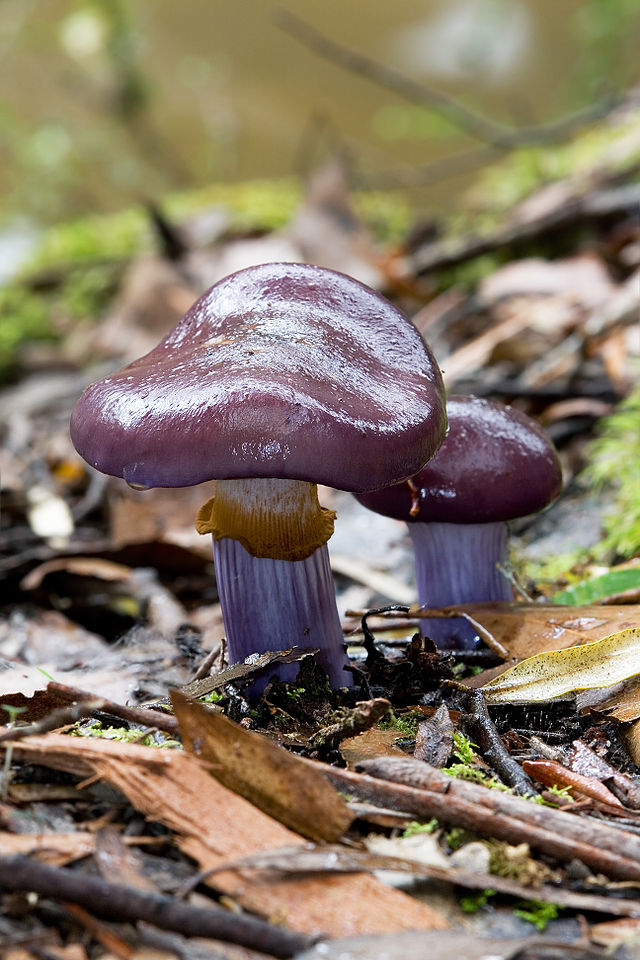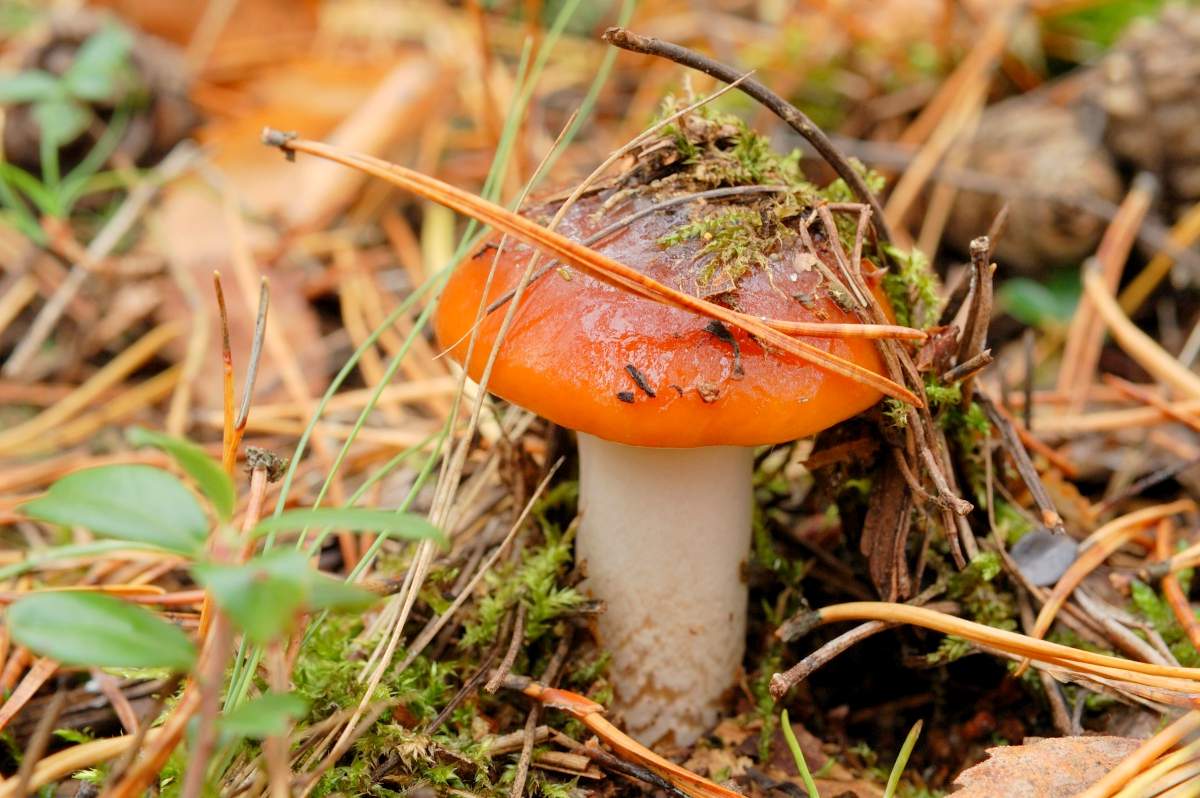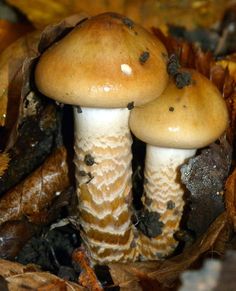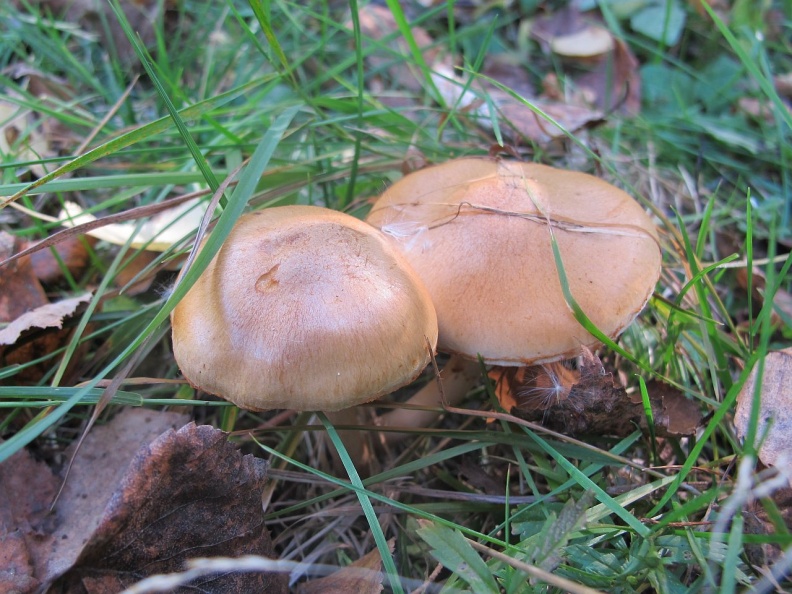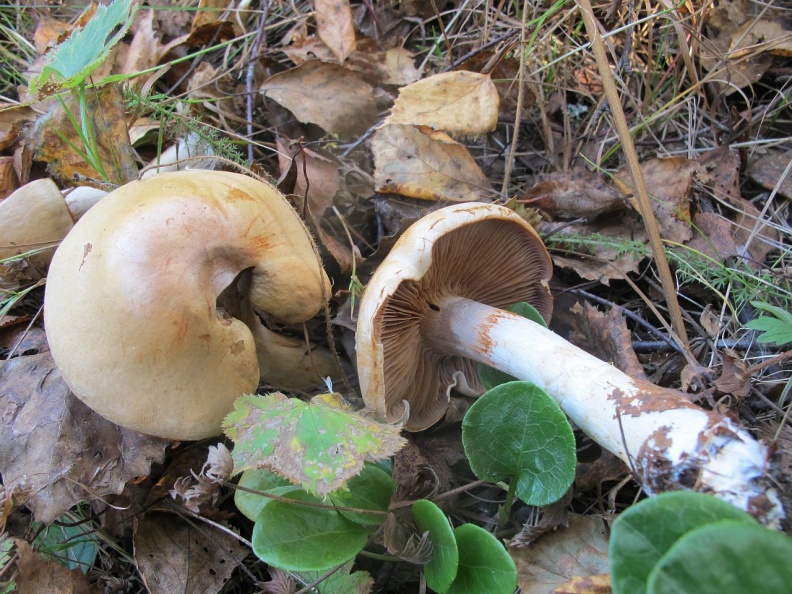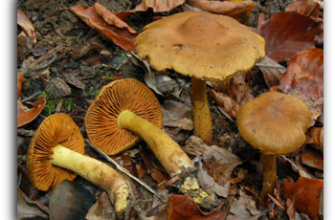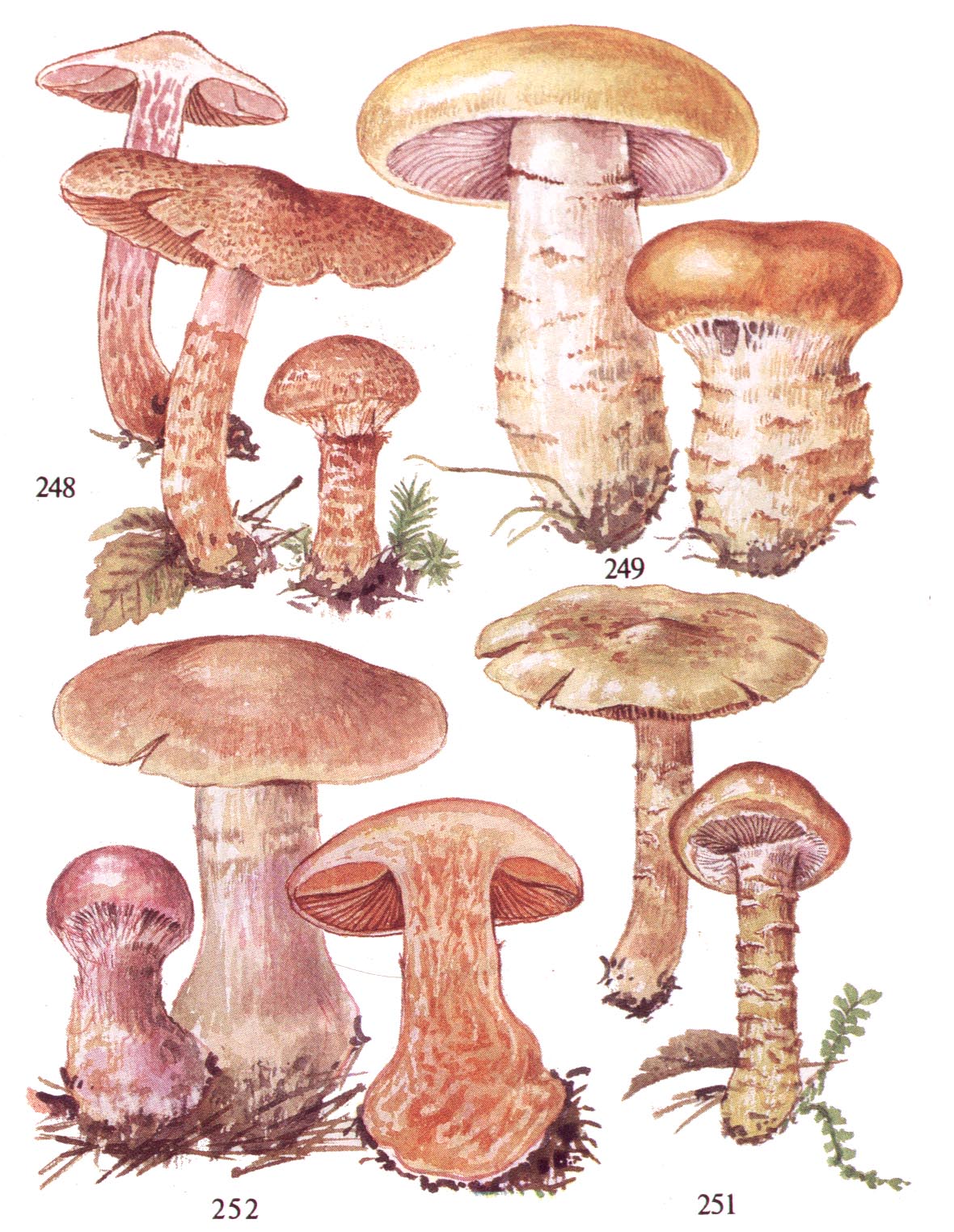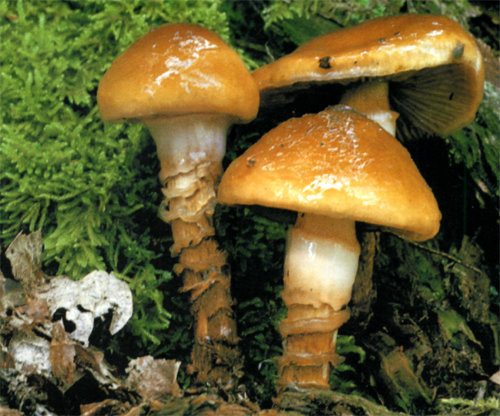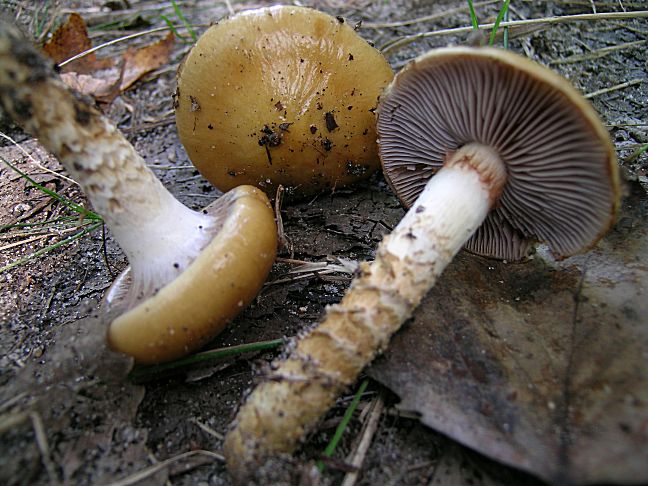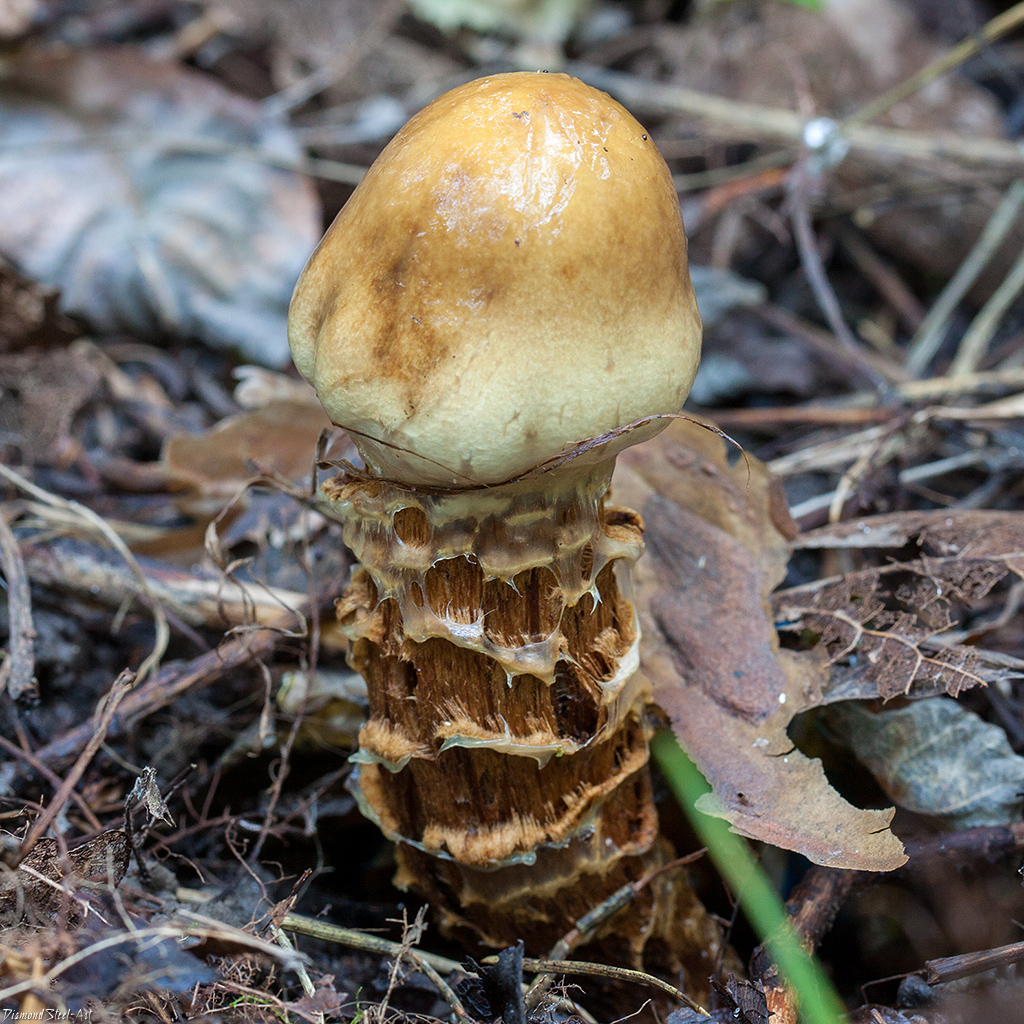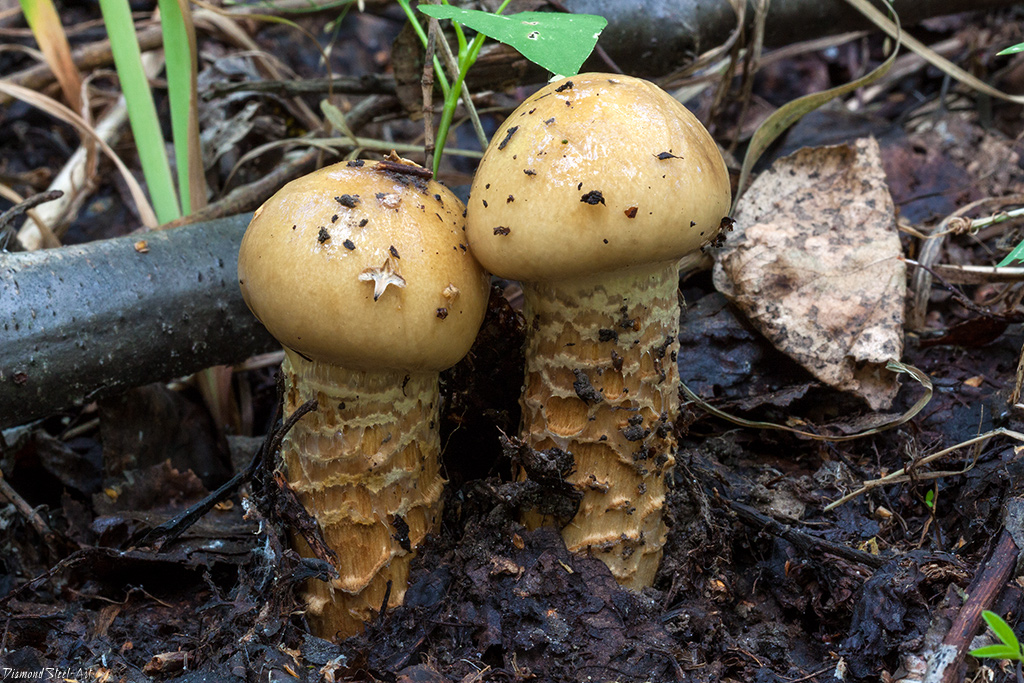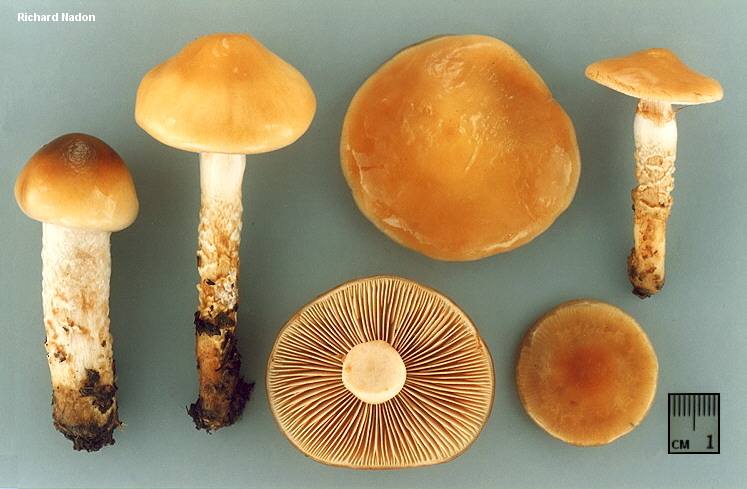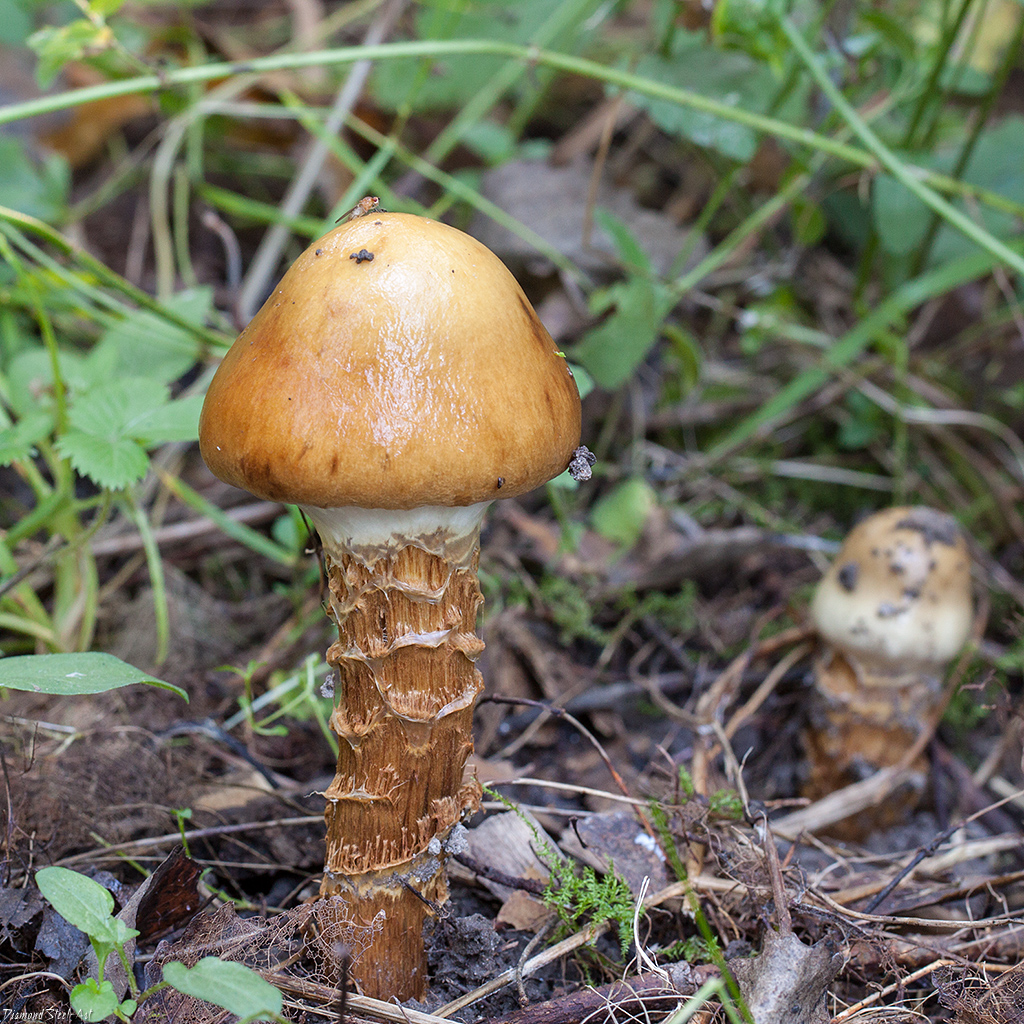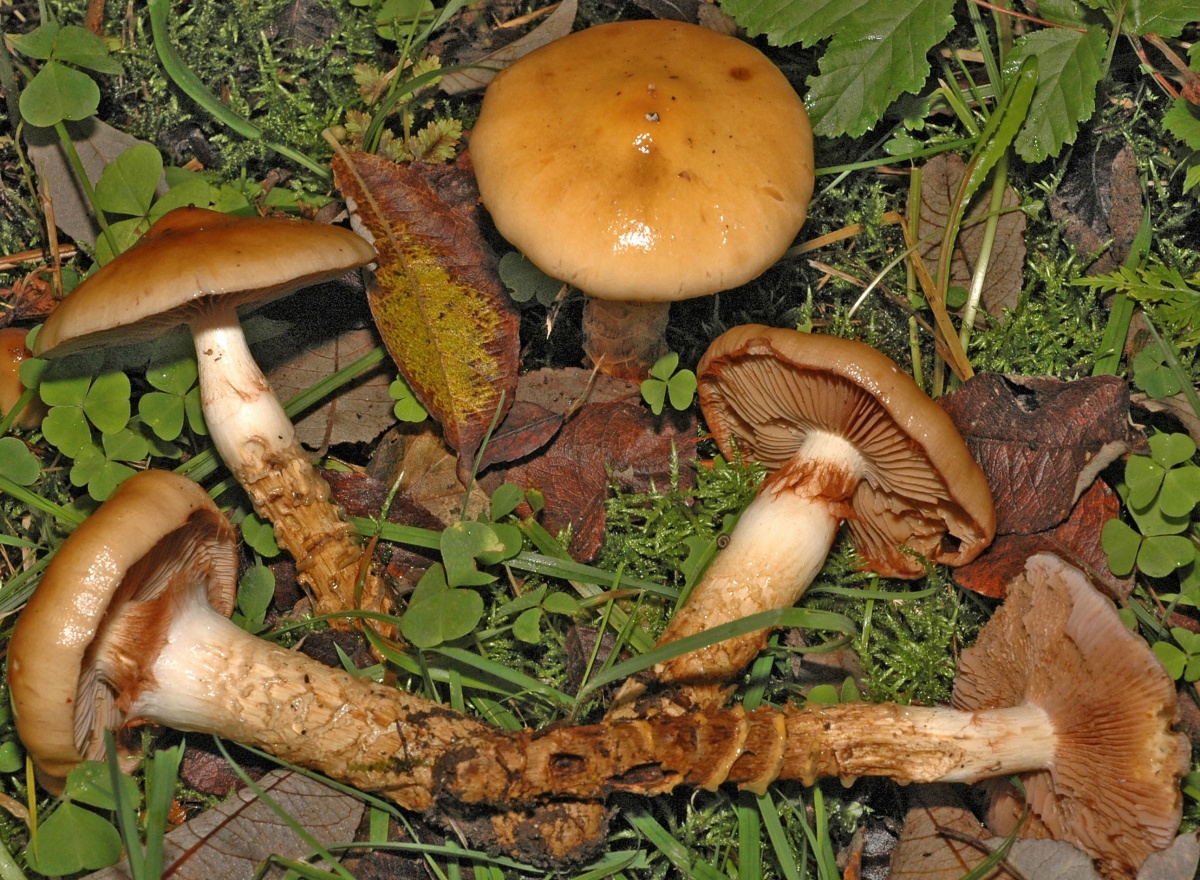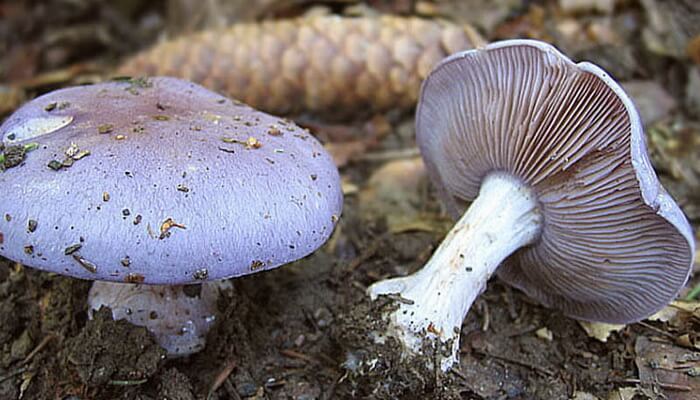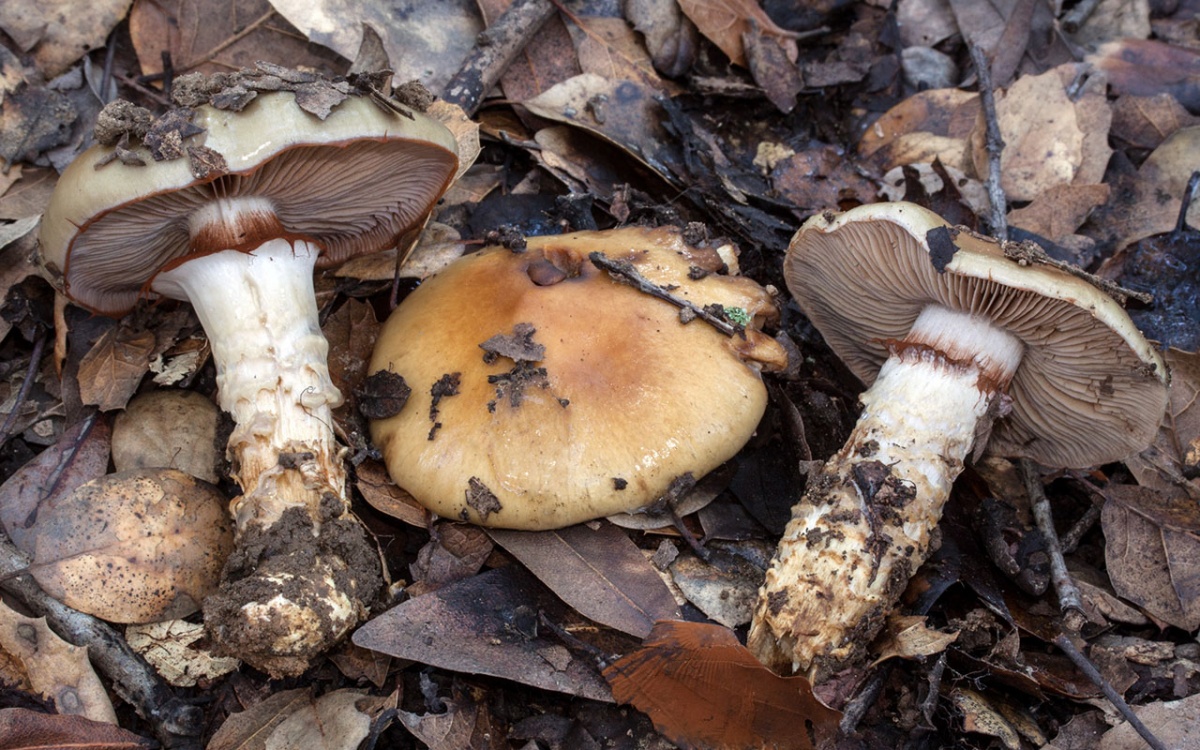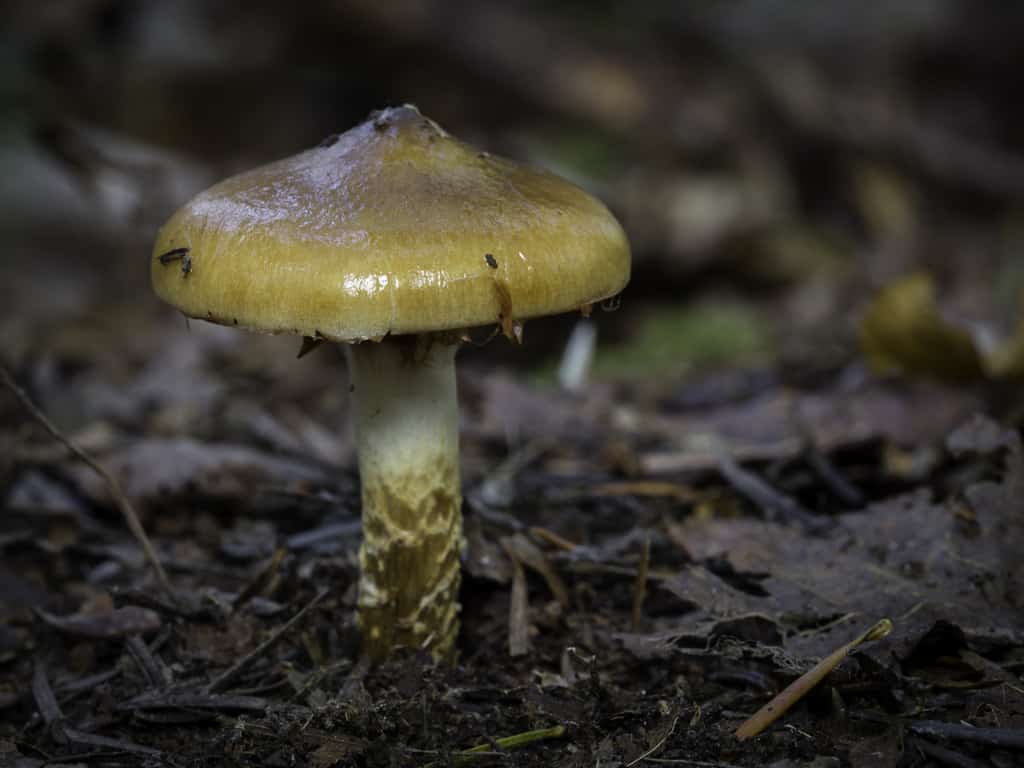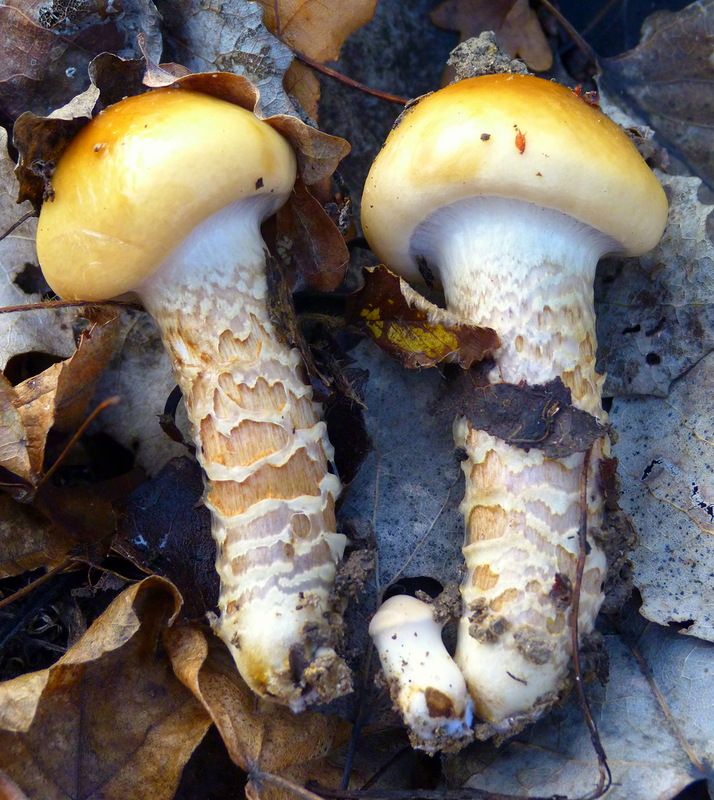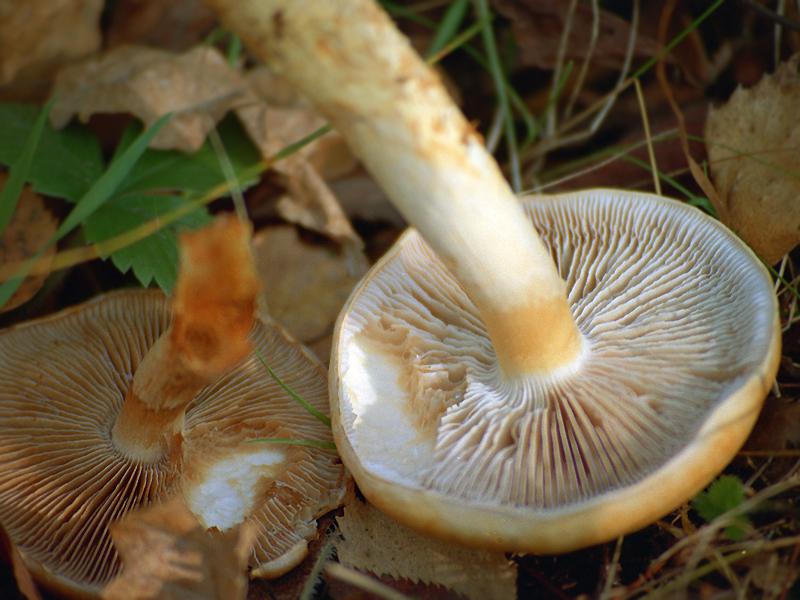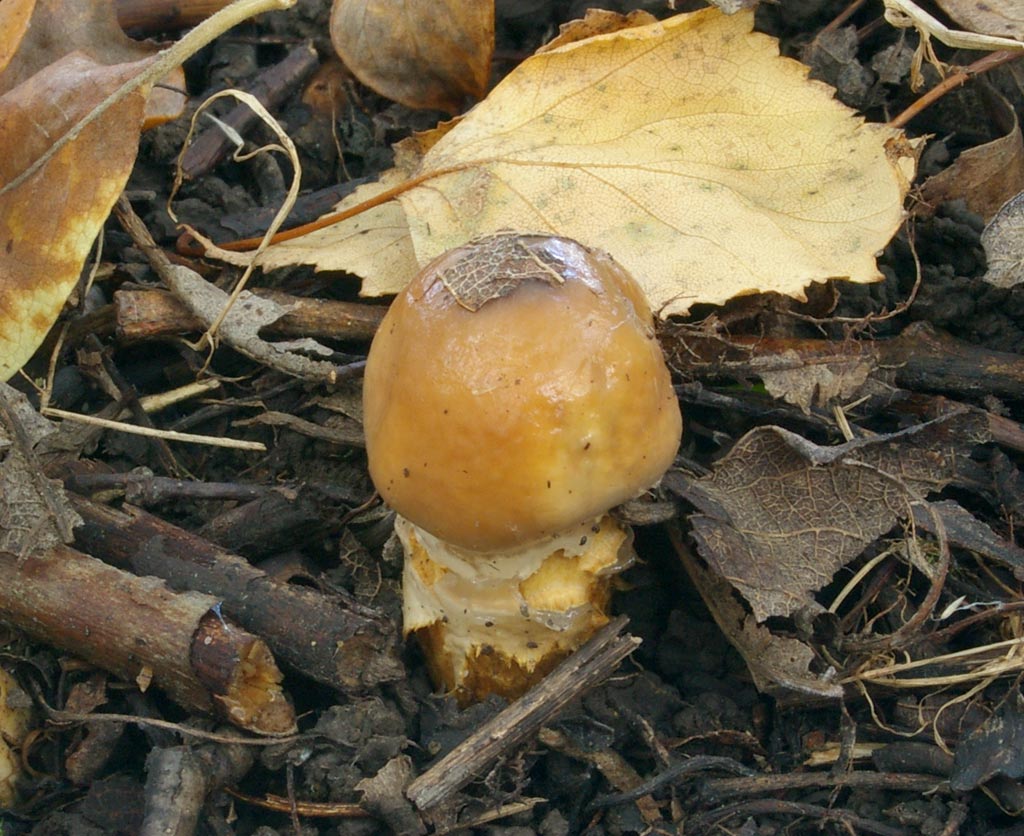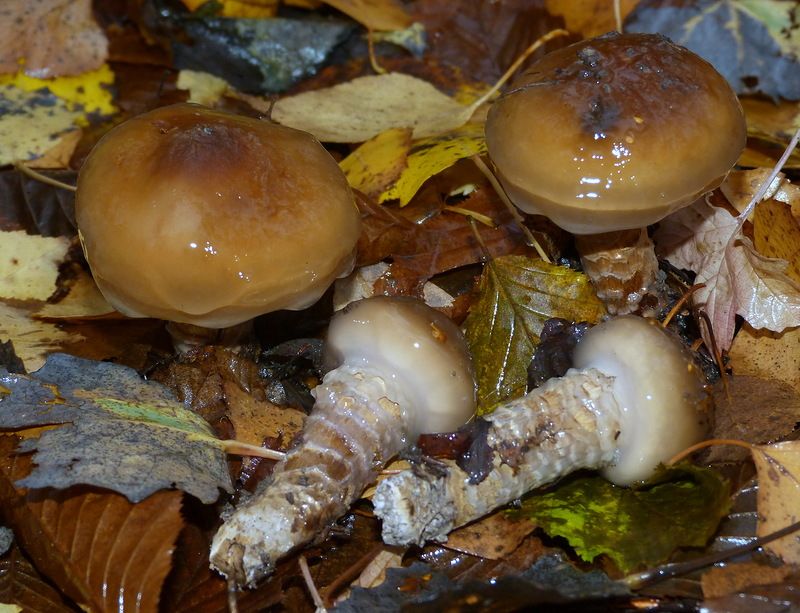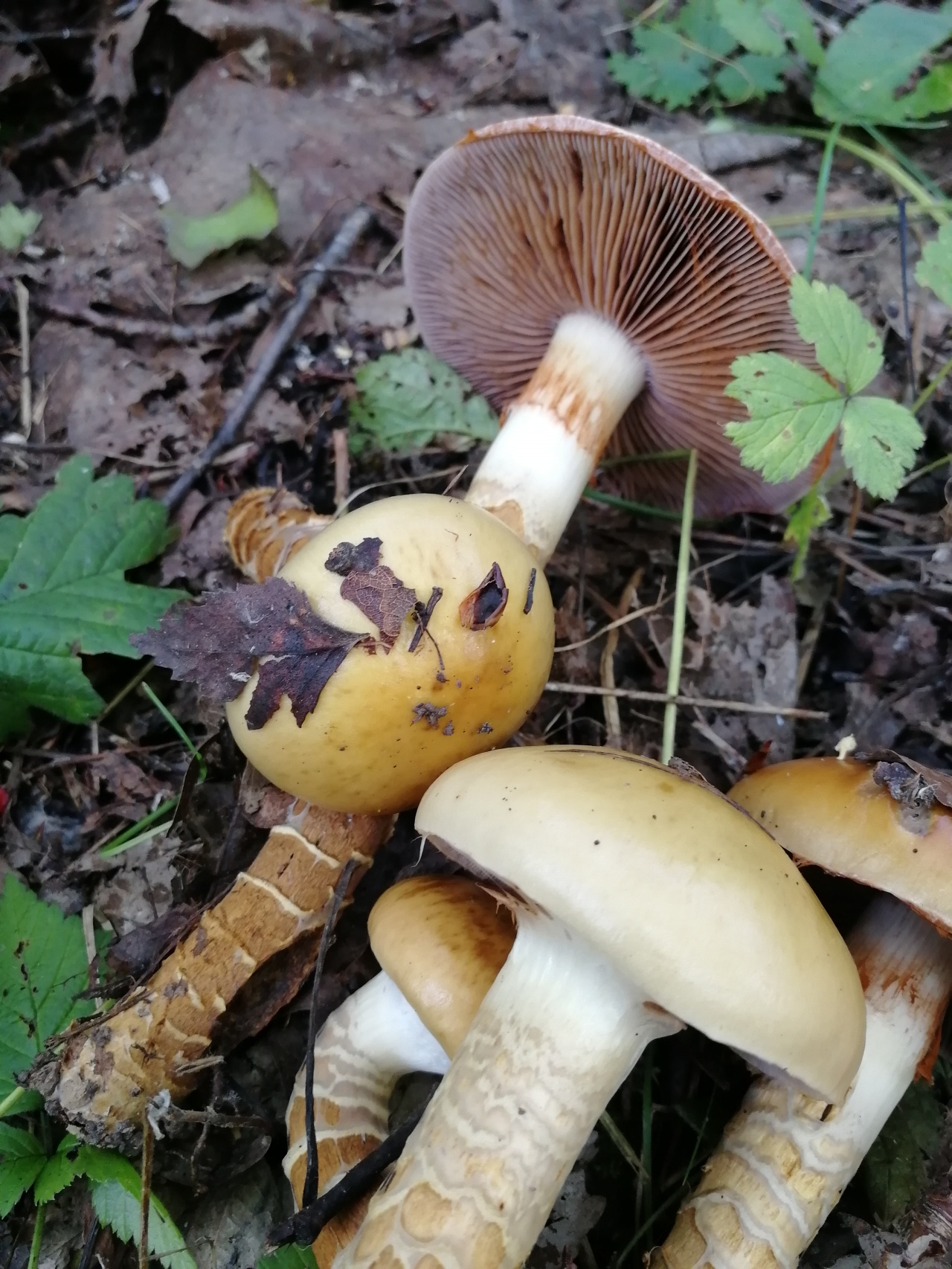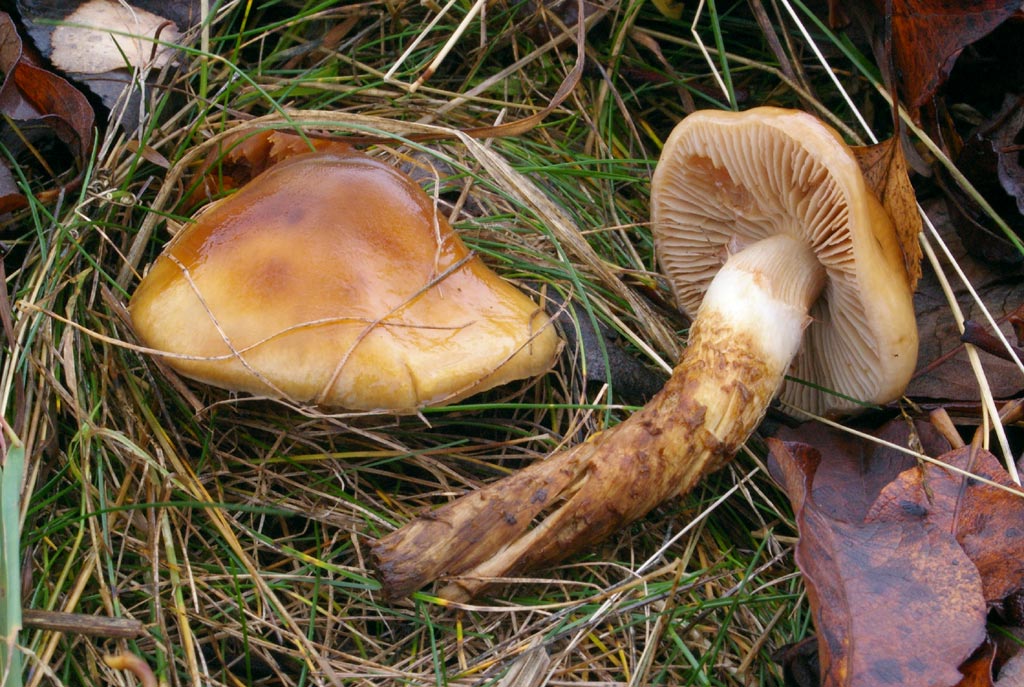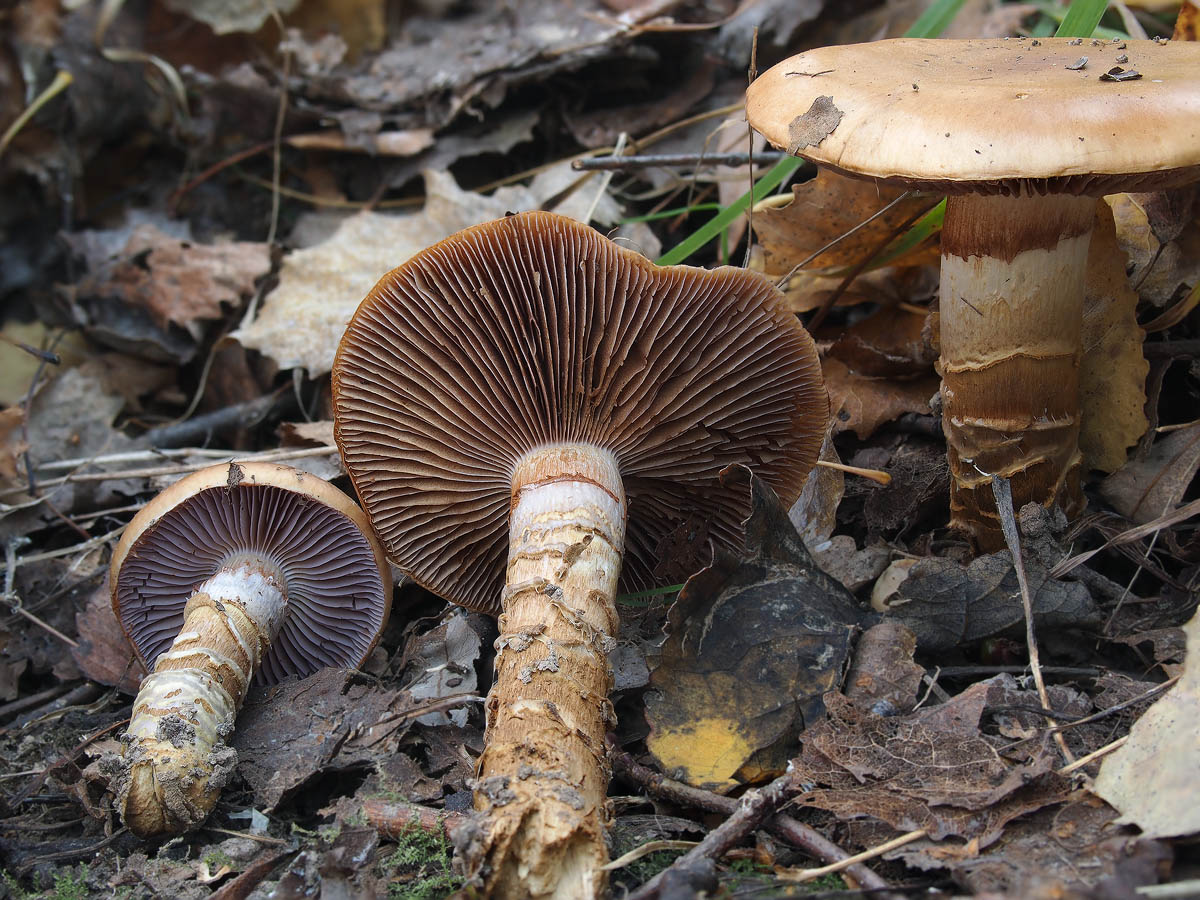White-purple spider web, Cortinarius alboviolaceus
Hat: Medium size (diameter 5-8 cm), fleshy, bell-shaped or hemispherical in youth, as the mushroom matures, it acquires a characteristic half-extended shape with a blunt tubercle in the center. Color - light gray or silvery with a purple tint; the surface is not slimy, smooth, silky, covered with rather rare radial fibers of a more violet color in comparison with the base. The pulp is thick, grayish, friable, with an unpleasant musty smell characteristic of many cobwebs.
Hymenophore: The plates are poorly adherent, of medium frequency, narrow, with frequent veins; in adult mushrooms, they are rusty-brown; in young ones, while covered with a light gray cortina, they are gray-gray, bluish, but already with rusty edges.
Spore powder: Rusty brown.
Leg: Long and powerful (height 6-10 cm, thickness 1.5-2 cm), cylindrical, evenly expanding to the bottom, cap color, often with blue stains. The remnants of the silvery cortina are usually not visible, but when ripening spores fall on it, it becomes rusty-brown in color and becomes very noticeable. The flesh of the leg is gray-bluish, unevenly colored, often watery and friable.
Spreading: The white-purple webcap is found in September-October in deciduous and mixed forests, forming a mycorrhiza with a variety of trees. Prefers moist places, mosses, where it can appear in large quantities.
Similar species: There are many similar mushrooms among the endless genus of spider webs. From more violet varieties such as Cortinarius traganus, the white and purple cobweb is easily distinguished by the color of the cap, which is never so blue; Unlike C. salor, our figurant's leg and cap are not particularly slimy, except maybe rain. How to distinguish Cortinarus alboviolaceus from the silvery spider web, Cortinarius argentatus, does not exist in the popular literature; obviously, one should rely on the presence or absence of blue tones in the color. In general, the distinction of cobwebs, even such noticeable as white and purple, is extremely unpromising.
Edibility: According to literature data, it is not poisonous; according to the same data, it does not bring gastronomic joy to anyone.
Author's notes: The reportable Cortinarius alboviolaceus is another cobweb that can be identified right in the forest with at least some nonzero probability. That's why we love him. If it is, of course, he.
The tubercle is not visible, but it is. The white-purple cobweb is somewhat smaller than most similar blue or purple cobwebs, but in texture this mushroom is not much different from them - the same powerful and lumpy-headed. Under the silvery layer on the cap and stem, the latent blue is clearly visible, which gives a good reason to record this specimen in Cortinarius alboviolaceus.
The plates are brown, and the stripes on the leg are rusty. The rusty stripes on the leg of this white and purple spider web are the remains of a cortina, strewn with spores of the corresponding color. Why are cobwebs good - you don't even need to make an eruption of spore powder, everything is in full view. However, this feature does not help in the definition. Such are the mushrooms - cobwebs. Woven, excuse the expression, of riddles and contradictions.
Tourist Saratov
New on the site
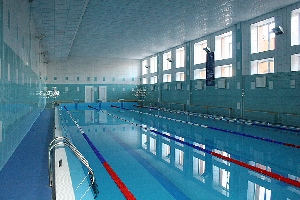

Saratov water parks and swimming pools

Swimming pool FOK Yuzhny
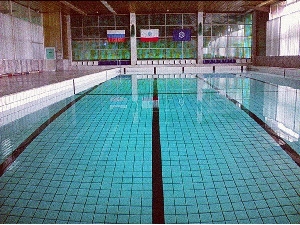
Water sports complex "RECORD"

Swimming pool SGYuA

Swimming pool FOK "Yubileiny"

Swimming pool FOK "Zavodskoy"
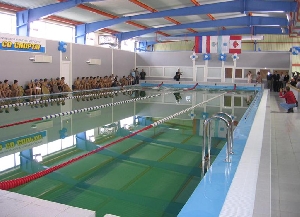
Pool of the family club "Friends"
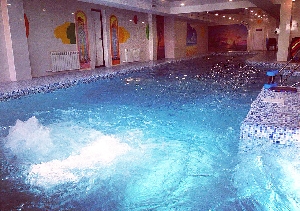
Swimming pool of the hotel and recreation complex "Dream"

Sports complex "Limkor"

Tent rest in Engelsky district

Places to rest with a tent on the Medveditsa River

Rest with tents in Marksovsky district


Places at the White Steep

Shcherbinovskie places for camping
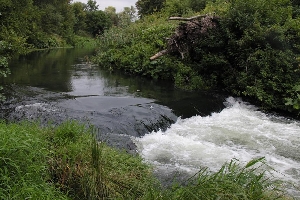
Tent rest in Voskresensky district
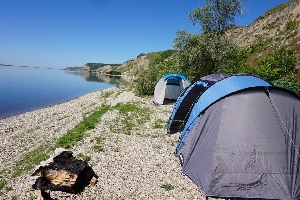

Church of the Nativity


Places for recreation with tents in the Krasnoarmeysky district

Prison Ravine Beach

Abandoned German churches in the Saratov region

The touching zoo "Zootopia"

Physical culture and recreation complex "Kristallik"

Open winter public ice rinks

Nomad "Fox Balka"
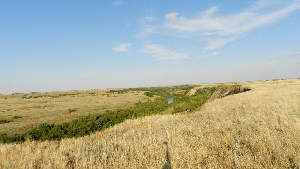
Paleontological and archaeological sites of the Saratov region
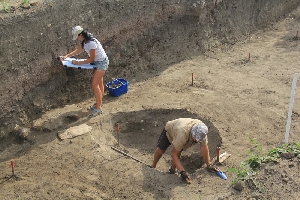
Monument to A.N. Tolstoy

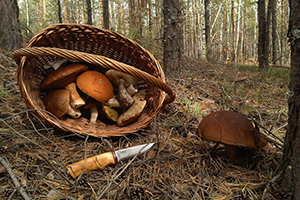
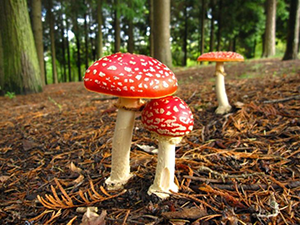
Poisonous and inedible mushrooms
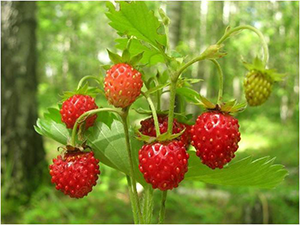
Edible berries, fruits and herbs

Plants of the Saratov region
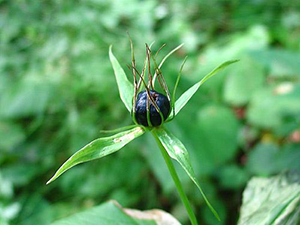
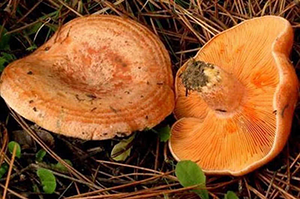

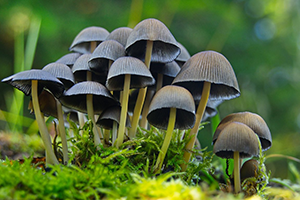

Medicinal trees and shrubs
Big webcap
Large webcap (Cortinarius largus)
Large webcap (Cortinarius largus) is a genus of mushrooms from the Spiderweb family (Kortinariyevs). It, like many other varieties of spiderwebs, is also called a bog.
External description
The cap of the large spider web has a convex-outstretched or convex shape. It is often gray-violet in color.
The flesh of a young fruiting body is purple in color, but gradually turns white. She has no characteristic taste and smell. The lamellar hymenophore consists of plates adherent to the tooth, slightly running down the leg. at first, the plates of the hymenophore are light purple in color, then they become pale brown. The plates are often located, contain a rusty-brown spore powder.
The leg of a large spider web comes from the central part of the cap, has a white or lavender color, which changes to brown towards the base. The leg is solid, filled inside, has a cylindrical shape and a clavate thickening at the base.
Season and habitat
The large cobweb grows mainly in coniferous and deciduous forests, on sandy soils. Very often this type of mushroom can be found on forest edges. Widely distributed in many European countries. The best time to collect a large spider web is the first month of autumn, September, in order to preserve the mycelium, the mushroom must be carefully twisted from the soil, clockwise, when collecting. To this end, the mushroom grabs the cap, turns 1/3 and immediately tilts downward. After that, the fruiting body is straightened again and gently lifted up.
Edibility
The large webcap (Cortinarius largus) is an edible mushroom that can be prepared immediately for consumption, or made from the mushroom for future use (canned, pickled, dried).
Recipes for the winter
Cooking a yellow webcap is easy because the process is quite simple. The mushroom does not require soaking and boils quickly. It will take a little patience and time to prepare it for the winter.
Salting
Pre-boiled mushrooms are placed in a prepared container, sprinkling each layer with salt. There should also be salt below and above. It is not necessary to use any spices for salting, the spider web is good in its natural form, its taste will be excellent. On top, put cheesecloth folded in several layers, a plate and press everything down with a load.
After 2-3 days, the mushrooms will be covered with brine, you need to periodically rinse the gauze or change it to a new one. This will help to avoid the appearance of mold. After 3 weeks, you can try the mushrooms.
Many housewives add various spices to improve the taste of salted mushrooms. May come in handy:
- Bay leaf;
- Dill;
- Carnation;
- horseradish and currant leaves;
- garlic and others.
You can use them at will, the proportions are also respected at personal discretion.
Drying
If you want to keep the cobwebs in a dried form, then preliminary boiling is not required. It is better not to wash the mushrooms, it is enough to clean the forest debris. After that, string on a string and hang in a sunny, well-ventilated place.
You can dry the fruits in the oven, for this, the oven is heated to 70 degrees, the pans on the baking sheet are installed inside. Turn them over from time to time to dry evenly.After 6-7 hours, the mushrooms are removed. Fruiting bodies should be cooled and placed in a closed container. Store in a dark place free of foreign odors.
Canning in jars
In order to preserve the podolotnik, for 2 kg of mushrooms you will need:
- salt - 300 g;
- dill - 3 umbrellas;
- horseradish leaf - 3 pcs.;
- garlic - 3 cloves;
- vegetable oil - 200 ml.
Cooking process:
- The washed and peeled mushrooms should be boiled in salted water for 40 minutes.
- Arrange the fruits in jars, add dill, garlic to each, and place a horseradish leaf on the bottom.
- Pour everything with broth, add 2 tbsp. To each jar on top. l. oils.
- Now you can roll up, cool and put away in a cool dark place.
This recipe is very simple, the main thing is that the jars are pre-steamed with boiling water and completely clean.
Edible spiderwebs
The first rule for those who are not looking for unnecessary difficulties in life can be formulated as follows: all mushrooms with a spider web are poisonous.
The second rule might sound like this: there are no edible cobwebs.
The third I would formulate as follows: they are still tasteless. In general, those who are not looking for difficulties do not lose anything.
Now we can talk about edible webcaps. Perhaps there are many. And probably: the genus Cortinarius is inexhaustible, as a well-known physical abstraction, and a significant part of it are mushrooms “in the body” - large, beautiful, fleshy, abundant. Even if we exclude from this series the cobwebs with suspicious names that hint at a certain smell, for example, goat cobwebs, goat cobwebs, camphor, the remainder will still be more than impressive. And if we add that the deadly poisonous representatives of this genus look, in general, so-so, they are puny and unappetizing, so it is not clear for what purpose people are poisoned with them, so if you do all these operations in your mind, you can come to unequivocal conclusion: you have to try.
And the first to try is the famous yellow webcap, or triumphant. He is very recognizable, there is a lot of him. He does not smell like a goat. It grows with a birch, especially often it can be found there (and then), where there is a black mushroom. A mixed spruce-birch forest is his native home. There is evidence that a very variable cobweb (Cortinarius trivialis) is often mistaken for a yellow spider web - at some stages of development they are extremely similar. It is curious that the edibility of the common cobweb is “not established”. But, apparently, they do eat without prescription. Although not necessary in theory.
By the way, justice requires admitting: a yellow spider web, pickled with a carnation, is quite good. The rare, collectible purple webcap is eaten for other reasons - precisely as a scarcity. (Remember? “Taste. Specific.”) Finding this rarity, sorting from dozens of other cobwebs painted in a similar way, and then eating - there is something solemn in this, something that disrupts the routine flow of mushroom reality.
And then there are “cousins of spider webs” - closely related mushrooms, allocated for some merit from the genus Cortinarius. There are few of them, but they are good. Bulbous webcap - a wonderful mushroom resembling a cobweb that imagined itself as a fly agaric - perfectly manifests itself in mushroomlessness. It can be fried like a champignon. The more popular ringed cap takes on a number. A large, very large number.
The remaining hundreds of potentially edible mushrooms of this genus are patiently waiting for the selfless natural scientist.
Yellow, or triumphant, is the most famous edible spider web. Many people collect it on purpose, and not out of despair. It is a large, abundant mushroom with firm flesh and no unpleasant odor common to many cobwebs. Ideal for long-lasting blanks (strong marinade with spices); amateurs use it boiled (lightly salted).
Purple webcap is a rare mushroom (although there are many purple webcaps, the rest are all smelly). Connoisseurs who have managed to find and distinguish this mushroom, first boil it (20 minutes), and then use it at their own discretion. You can marinate.However, it is probably better to leave this amazing mushroom in the forest.
The mushroom looks unpresentable, but the appearance is deceiving. It does not spoil the mushroom platter, it sounds dignified both in hot and in broth, and in marinade. A small number does not allow you to experience the white-webbed bulbous separately, but if we talk about mixing, then it can be fried with wild mushrooms without any boiling.
In countries with an undeveloped mushroom culture ringed cap is considered a delicacy mushroom... We have mostly toadstool. The truth is somewhere nearby: the mushroom tastes good and is great for harvesting. Salting, pickling is a sweet thing. It is also used lightly salted (boiled with salt, garlic, dill). The legs of adult mushrooms are harsh, it is better to remove them.
Changeable webcap (multi-colored): photo and description
| Name: | The cobweb is changeable |
| Latin name: | Cortinarius varius |
| Type of: | Conditionally edible |
| Synonyms: | Webcap multicolored, Webcap brick-brown sticky |
| Specifications: |
|
| Systematics: |
|
The changeable webcap is a representative of the Spiderweb family, the Latin name is Cortinarius varius. Also known as multi-colored spiderweb or brick brown gooey.
What a changeable spider web looks like

On the edge of the cap, you can see the remnants of a brown bedspread
The fruit body of this species consists of a fleshy cap and a rather thick stem. The spore powder is colored yellow-brown. The pulp is whitish, dense, firm, with a subtle musty odor.
Description of the hat
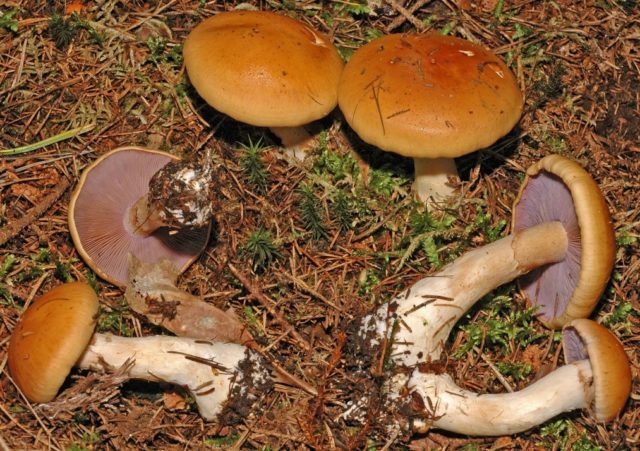
Has many poisonous and inedible counterparts
In young specimens, the cap is hemispherical in shape with the edges tucked inward, as it grows up, it becomes convex. The diameter varies from 4 to 8 cm, but there are specimens in which the cap reaches 12 cm. Adult mushrooms are distinguished by drooping or curved edges. The surface is slimy, colored orange-brown with lighter edges and a dark red center. On the underside of the cap there are frequent plates, the color of which is purple at the initial stage of ripening, over time it becomes pale brown. In young specimens, a white veil is well traced.
Leg description
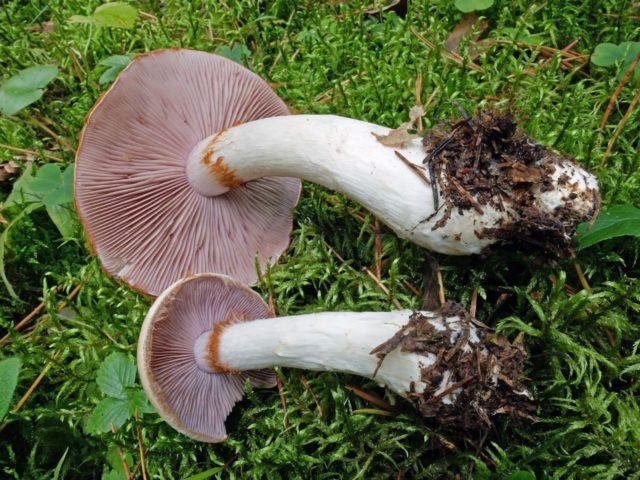
Can grow one at a time or in small groups
The leg of the cobweb is characterized as clavate, its length varies from 4 to 10 cm, and its thickness is from 1 to 3 cm in diameter. Some specimens may have a thick tuber at the base. The surface is smooth, dry, silky to the touch. Initially white, gradually turns yellowish. A ring of light brown color is located almost at the base of the leg.
Where and how it grows
This species prefers coniferous and deciduous forests, most often found in the southern and eastern regions. The best time for fruiting is from July to October.
Is the mushroom edible or not
The mutable webcap belongs to the group of conditionally edible mushrooms. In Europe, this species is considered edible and is quite popular. Suitable for cooking main courses, pickling and salting.
Doubles and their differences
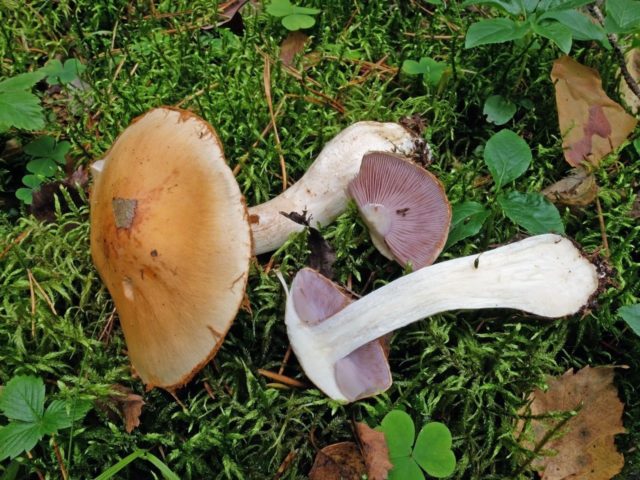
The pulp is white, slightly bitter
In appearance, the changeable spider web is similar to some of its relatives:
- The common webcap is an inedible species. Initially, the double's hat is hemispherical with a curved edge, gradually becoming prostrate. Its color ranges from pale yellow or ocher to honey brown, with the middle always darker than the edges. A special feature is the girdle on the leg, which is a concentric fiber of brown or yellow-brown color.
- Straight webcap - belongs to the group of edible mushrooms.You can distinguish a double by a straight bluish or lavender leg. It is not often found, it is located in deciduous or mixed forests where aspens grow.
Conclusion
The changeable webcap can be found in deciduous and coniferous forests. In some foreign countries, dishes from this specimen are considered a delicacy, and in Russia it is classified as conditionally edible mushrooms. You can eat it, but only after preliminary processing
In addition, it is important to make sure of the authenticity of the species, since the mutable webcap has many inedible and even poisonous twins, the use of which can lead to serious poisoning
Common webcap (Cortinarius trivialis) what it looks like, where and how it grows, edible or not
Common webcap: photo and description
| Name: | Common webcap |
| Latin name: | Cortinarius trivialis |
| Type of: | Inedible |
| Specifications: |
|
| Systematics: |
|
The common webcap (lat.Cortinarius trivialis) is a small mushroom of the Cobweb family. The second name - Pribolotnik - he received for preference to growing conditions. It is found in wet, swampy areas.
A detailed description of the Common Webcap with photos and videos is presented below.
Description of the common webcap
The mushroom was called a cobweb for a kind of "veil" of a cobweb film that is present in young specimens. The rest of the appearance is unremarkable.
Description of the hat
Pribolotnik's cap is small: 3-8 cm in diameter. At the initial stage of development, it has the shape of a hemisphere, which is later revealed. The color of the cap ranges from pale yellow tones to ocher and light brown shades. The core is darker than the edges.
The cap is sticky to the touch, there is a small amount of mucus on it. The surface of the hymenophore is lamellar. In young fruit bodies, it is white, and in mature specimens it darkens to yellowish and brown tones.
The pulp is dense and fleshy, white, with a harsh odor.
Leg description
The leg is 6-10 cm in height, the diameter is 1.5-2 cm. Slightly narrowed towards the base. There are specimens with a reverse structure - there is a small expansion at the bottom. The color of the leg is white, closer to the ground it darkens to a brown tint. Above from the cobweb blanket are brown concentric fibrous bands. From the middle of the leg to the base - weakly expressed.
Where and how it grows
Podbolnik can be found under birches and aspens, rarely under alder. It rarely lives in coniferous forests. Grows singly or in small groups in damp places.
In Russia, the distribution area of the species falls on the middle climatic zone.
Fruiting from July to September.
Edible webcap common or not
The nutritional properties of the Common Webcap have not been studied, but it does not apply to edible mushrooms. This species cannot be eaten.
Related specimens contain dangerous toxins in the pulp.
Poisoning symptoms, first aid
The danger of toxic species of this family is that the first signs of poisoning appear gradually: up to 1-2 weeks after eating mushrooms. Symptoms look like this:
- intense thirst;
- nausea, vomiting;
- stomach ache;
- spasms in the lumbar region.
If you find the first signs of poisoning, you must urgently consult a doctor or call an ambulance. Before receiving qualified treatment, you need to:
- flush the stomach using activated charcoal;
- plentiful drink (3-5 tbsp. boiled water in small sips);
- take a laxative to cleanse the intestines.
Doubles and their differences
The podbolnik is confused with other members of the family, as they are quite similar. The greatest similarity is noted with the Slimy Webcap (lat.Cortinarius mucosus).
The hat is 5-10 cm in diameter. It has a thin edge and a thick center, abundantly covered with transparent mucus. The leg is slender, cylindrical, 6-12 cm long, 1-2 cm thick.
It differs from Pribolotnik in abundant mucus and the shape of a cap.
Grows in coniferous and mixed forests under pine trees. Bears fruit singly.
The slime webcap (lat.Cortinarius mucifluus) is another twin of the Pribolotnik, which is confused with the mucous webcap because of a similar name. The hat with a diameter of 10-12 cm is abundantly covered with mucus. The stem is 20 cm long in the form of a spindle, also covered with mucus. Prefers coniferous forests.
It differs from Pribolotnik in abundant mucus and a longer leg.
Conclusion
The common webcap is an inedible mushroom, its properties have not been fully studied. Can be confused with other members of the family, the use of which is not recommended. The greatest similarity is noted with the Slime Webcap and the Slime Webcap, but they can be distinguished by their cap. In the latter, it is abundantly covered with mucus.
Additional information about the common webcap:


